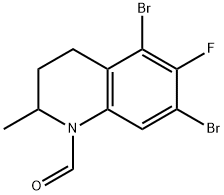143703-25-7
 143703-25-7 結(jié)構(gòu)式
143703-25-7 結(jié)構(gòu)式
基本信息
CE3F4 >=98% (HPLC)
5,7-Dibromo-6-fluoro-3,4-dihydro-2-methyl-1(2H)-quinolinecarboxaldehyde
1(2H)-Quinolinecarboxaldehyde, 5,7-dibromo-6-fluoro-3,4-dihydro-2-methyl-
| 報(bào)價(jià)日期 | 產(chǎn)品編號 | 產(chǎn)品名稱 | CAS號 | 包裝 | 價(jià)格 |
| 2024/08/19 | HY-108539 | 143703-25-7 CE3F4 | 143703-25-7 | 5mg | 600元 |
| 2024/08/19 | HY-108539 | 143703-25-7 CE3F4 | 143703-25-7 | 10mM * 1mLin DMSO | 660元 |
| 2024/08/19 | HY-108539 | 143703-25-7 CE3F4 | 143703-25-7 | 10mg | 1000元 |
常見問題列表
IC50: 10.7 μM (Epac1), 66 μM (Epac2(B))
CE3F4 is a selective antagonist of Epac1, with IC 50 s of 10.7 μM and 66 μM for Epac1 and Epac2(B), respectively. CE3F4 is more active on Epac1 than (S)-stereoisomer ((S)-CE3F4, IC 50 , 56 μM), but less active than (R)-CE3F4 (IC 50 , 5.8 μM). CE3F4 (50 μM) shows more inhibitory activities against GEF activity of Epac1, than that of Epac2(AB) or Epac2(B). CE3F4 reduces the exchange activity of Epac1 induced by 007, with IC 50 of 23 ± 3 μM. CE3F4 (40 μM) specifically inhibits Epac1 guanine nucleotide exchange activity without interference with Rap1 activity or Epac1-Rap1 interaction. CE3F4 has no influence on PKA activity. CE3F4 (20 μM) inhibits Epac-induced Rap1 activation in living cultured HEK293 cells. CE3F4 (20 μM) significantly inhibits the late phase of ERK activation stimulated by glucose in INS-1 cells.
CE3F4 (1-3 mg/kg; through a catheter in the internal jugular vein) inhibits atrial fibrillation (AF) and CE3F4 (3 mg/kg; i.v.) inhibits ventricular arrhythmias.
CE3F4 (10 mg/kg; i.v.) improves cardiac function after myocardial infarction in mice.
| Animal Model: | Wild-type (WT) mice (induced AF after 20min of CE3F4 administration) |
| Dosage: | 3 mg/kg and 1mg/kg |
| Administration: | Through a catheter in the internal jugular vein |
| Result: | Shortened the duration of the pacing-induced AF at 3mg/kg. |
| Animal Model: | Casq2-KO mice (premature ventricular contraction induced by isoproterenol injection 20min after CE3F4 administration) |
| Dosage: | 3 mg/kg |
| Administration: | I.v. |
| Result: | Reduced the incidence of sympathetic activation-induced ventricular arrhythmias. |

